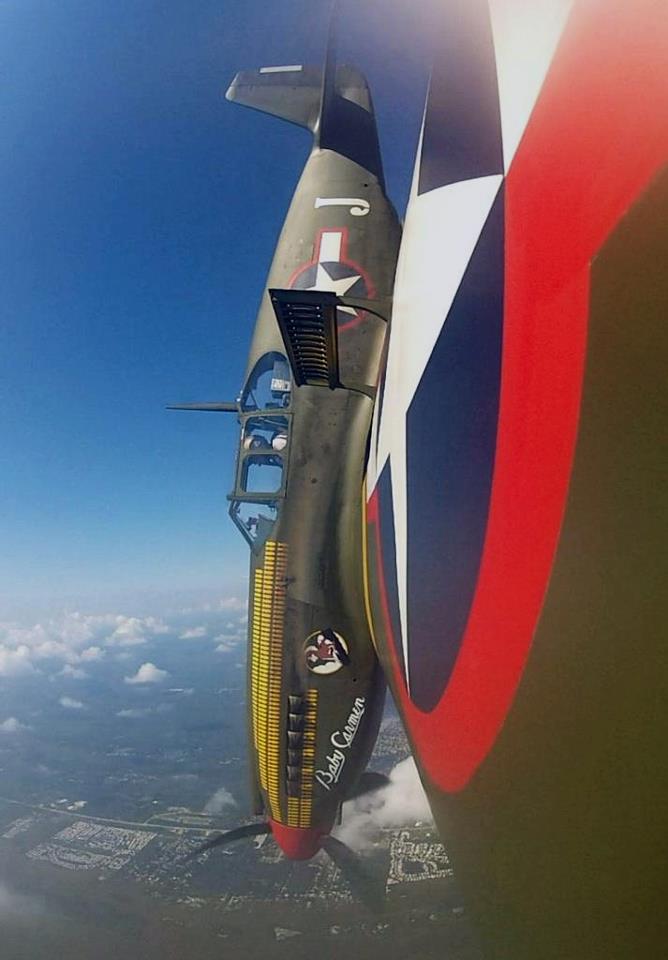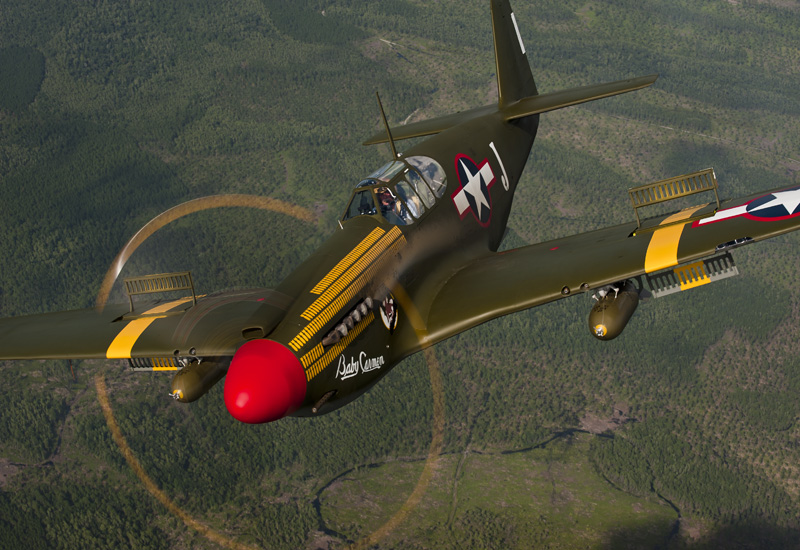Story courtesy of the Collings Foundation. All photos by David Leininger
 After more than ten years of restoration, the Collings Foundation’s A-36A s/n 42-83738 is complete. This is one of three A-36 aircraft in existence and one of two currently flying in the world. The quality of craftsmanship and attention to detail is some of the finest in the history of warbird restoration. The dedication and commitment provided by American Aero Services of New Smyrna Beach, Florida is clearly evident in the restoration of this legendary aircraft. In recognition of its rarity and high quality of restoration this A-36 was awarded Grand Champion at EAA’s 2012 AirVenture.
After more than ten years of restoration, the Collings Foundation’s A-36A s/n 42-83738 is complete. This is one of three A-36 aircraft in existence and one of two currently flying in the world. The quality of craftsmanship and attention to detail is some of the finest in the history of warbird restoration. The dedication and commitment provided by American Aero Services of New Smyrna Beach, Florida is clearly evident in the restoration of this legendary aircraft. In recognition of its rarity and high quality of restoration this A-36 was awarded Grand Champion at EAA’s 2012 AirVenture.
The A-36 Apache was the ground-attack /dive bomber version of the early P-51 Mustang. The A-36 is similar to the P-51A Mustang, with the notable exception that it sports large slatted dive brakes above and below the wings. Designed by Edgar Schmued and manufactured by North American Aviation, the A-36 was introduced in 1942 (original designation was NA-97) and retired from service in 1945. Five hundred were built, and they served in the Mediterranean, North Africa, Italy and China/Burma/India theaters.
Between the warbird enthusiasts and historians, there is some confusion and disagreement about the correct name for the A-36. According to the research and findings of some like Joe Baugher, “names such as Invader and Apache have been associated with the A-36, but the more correct name is the Mustang. There was a brief effort to change the name of the A-36 to Invader following the invasion of Sicily in order to distinguish it from the fighter versions in press coverage. The Army turned down the request, as they didn’t want to reveal to the enemy that they were facing a dive-bomber version of the fighter. In addition, the name Invader had already been assigned to the Douglas A-26. There is a persistent myth that the A-36 was initially called Apache, which was the name that the Army had initially assigned to the very early P-51. However, this story has no basis in fact, and was supposedly a myth that originated in the 1980s.”

The A-36 was used to replace/supplement the Curtiss P-40 Tomahawks already in service. In 1942, the A-36 began flying combat missions as a low-altitude reconnaissance and ground support aircraft with the Army Air Force Squadrons. Immediately, the A-36 became a very effective and popular fighter/ dive-bomber. Despite the limited high altitude performance from the Allison V-1710 engine, the AAF enthusiastically received the new aircraft.
The liquid cooled V-12 Allison engine can produce approximately 1,325 hp resulting in a cruise speed of 250 mph. Maximum speed is 365 mph with a range of 550 miles and a service ceiling of 25,000 feet. Typical armament consisted of up to 1,000 pounds of bombs and 6 M-2 Browning machine guns.
The A-36 proved to be a very effective weapon. The aircraft could be put into a vertical dive at 12,000 feet and the pilot would deploy the dive brakes that would limit the dive speed to 390 mph. Depending on the target and conditions, the pilots would release the bombs between 4,000 ft and 2,000 feet. With proper technique, pilots were able to achieve consistent and deadly results. The A-36 also had an impressive number of aerial victories, with 84 enemy aircraft shot down.
The first two units to receive the A-36 were the 27th Bombardment Group and the 86th Bombardment Group of the 12th Air Force. The 27th was first into combat. On June 6th, 1943, the 27th carried out its first mission over the Italian island of Pantelleria.
Reconnaissance and ground attack missions commenced and continued through early June. In June A-36 aircraft encountered the feared Messerschmitt Bf 109G fighters. They shot one 109 down and it was credited as a group victory. Beginning on July 10th, 1943 both A-36 “Apache” units supported the Allied invasion of Sicily. The losses were severe mostly due to how the A-36 squadrons set their attack configurations. The A-36 pilots would begin a vertical dive in V-formation at around 8,000 feet. Bombs were released between 4,000 and 2,000 feet.
Initially the enemy would be caught off guard and surprised but, the enemy learned quickly. Once the remaining aircraft came into view, they were easy targets for well-practiced German anti-aircraft crews. Another effective tactic to down an A-36 was stringing wire across mountain ridges. After the A-36 dive-bombed a target the pilot would fly at treetop level, at blazing speeds, shooting ground targets along the way back to base. In some cases, the pilot would fly into these low-strung wires, shredding the aircraft in two.
 The first A-36 / P-51 Mustang Ace was Michael Russo. He was assigned to the 27th Bombardment Group, 12th Air Force operating in the Mediterranean Theatre of Operations. When his unit started to fly missions over mainland Italy Russo scored his aerial victories. His first triumph was shooting down a Fw 190F near Salerno. Russo’s second confirmed victory was a Fieseler Fi 156 Storch. This, we can imagine, would either be a very easy target to hit, or a very difficult target to hit depending on the A-36 airspeed at the time of targeting. The Storch has a cruise speed of around 40 knots. So Russo might have had this aircraft in his sights for only a fraction of a second before overtaking the enemy target. His third score came from shooting down a Ju 52. Russo achieved his two final victories in 1943. He downed two Bf 109G fighters near Rome when his formation intercepted sixteen German aircraft at 4,500 feet.
The first A-36 / P-51 Mustang Ace was Michael Russo. He was assigned to the 27th Bombardment Group, 12th Air Force operating in the Mediterranean Theatre of Operations. When his unit started to fly missions over mainland Italy Russo scored his aerial victories. His first triumph was shooting down a Fw 190F near Salerno. Russo’s second confirmed victory was a Fieseler Fi 156 Storch. This, we can imagine, would either be a very easy target to hit, or a very difficult target to hit depending on the A-36 airspeed at the time of targeting. The Storch has a cruise speed of around 40 knots. So Russo might have had this aircraft in his sights for only a fraction of a second before overtaking the enemy target. His third score came from shooting down a Ju 52. Russo achieved his two final victories in 1943. He downed two Bf 109G fighters near Rome when his formation intercepted sixteen German aircraft at 4,500 feet.
It is believed that issues with the drive brakes were discovered during the battle of Sicily. Although the flight records are not clear or conclusive, it is known that the left and right dive brakes tended to open asymmetrically, making the dive highly unstable. To further the legend, it is believed that flight mechanics would wire shut the dive brakes to prevent this potential catastrophe. The majority of airmen flying the aircraft in combat conditions claim this to be false.
A-36 # 42-83738 went on flying as a trainer aircraft through WWII and then was put in storage. In 1963, Sid Smith in Sheridan, IL, purchased the aircraft. It was transferred to Wings of Yesterday Museum in Santa Fe in 1975 and then to John Paul in 1980. The Collings Foundation acquired the aircraft in the late 80’s. Major restoration work started in 2004 when the aircraft was transferred to American Aero Services.
At the final stage of restoration the Foundation’s A-36 was painted in honor of a 526th FSB, 86th FG aircraft named “Baby Carmen.” Two pilots flew the original aircraft: Lt. Gibson and Lt. Lucas. Mike Brown was the crew chief. The original “Baby Carmen” logged an astounding 200 combat sorties without an engine replacement. It is painted with a US national insignia in four positions with a red surround, a white rudder tab marked the 526th, and a ‘J’ for the squadron. Like the original “Baby Carmen” paint scheme, the Collings Foundation’s A-36’s insignia and nose art was finely rendered by hand.
We plan to fly this incredible aircraft in honor of our A-36 pilots, crew and all WWII Veterans. Check the Collings Foundation’s website for A-36 appearance schedules and more information.
Courtesy of the Collings Foundation. Visit them here.
